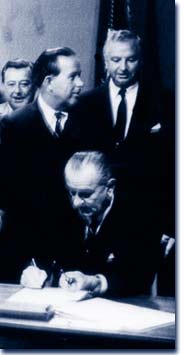History
OBJECTIVES
 This portion of the tutorial provides a brief history of statute referred to as
This portion of the tutorial provides a brief history of statute referred to as
Section 4(f). When you have finished, you should have a basic understanding of the
statute's origins and intent.
OVERVIEW
Since the mid-1960s, federal transportation policy has reflected an effort to preserve publicly owned public parks and recreation areas, waterfowl and wildlife refuges, and historic sites considered to have national, state or local significance. The Department of Transportation Act (DOT Act) of 1966 included a special provision to carry out this effort, which was Section 4(f).
Section 4(f) of the DOT Act stipulated that the Federal Highway Administration (FHWA) and other U.S. Department of Transportation (DOT) agencies cannot approve the use of land from a significant Significant means that in comparing the availability and function of the resource with the recreational, park, and refuge objectives of that community, the resource in question plays an important role in meeting those objectives. publicly owned Property that is owned by a government authority via either fee simple ownership or permanent easement. public park, recreation area, wildlife or waterfowl refuge, or any significant historic site unless the following conditions apply:
- There is no feasible and prudent A feasible and prudent avoidance alternative avoids using Section 4(f) property and does not cause other severe problems of a magnitude that substantially outweighs the importance of protecting the Section 4(f) property. alternative to the use of land.
- The action includes all possible planning to minimize harm to the property resulting from use.
Since 1966, Section 4(f) has undergone several changes, although none of them has affected the preservation purpose of the statute. The first of these changes was a 1968 amendment to Section 4(f)'s wording-an effort by lawmakers to reconcile the language of 49 U.S.C. Section 1653(f) and 23 U.S.C. Section 138. The wording in the two provisions was somewhat different; therefore, the Federal-Aid Highway Act of 1968 amended the wording in both sections to be consistent. The second change was a result of the 1983 recodification of the DOT Act, in which Section 4(f) became 49 United States Code (U.S.C.) Section 303. (Technically speaking, the statute is no longer Section 4(f); however, because of its widespread familiarity among state and federal agencies, it continues to be referred to by its original name.)
In 2005, Congress made more substantial changes to provide an additional method for approving the use of Section 4(f) properties when the impact to those properties are so minor they are considered de minimis. This de minimis impact provision establishes the basis for U.S. DOT agencies to approve the minor use of Section 4(f) properties without evaluating avoidance alternatives, thereby simplifying the approval process. Congress also directed the U.S. DOT to revise its Section 4(f) regulations to clarify the application of the feasible and prudent standard. In 2008, the FHWA and Federal Transit Administration issued a joint regulation – 23 CFR 774 – to accomplish this and to update other aspects of Section 4(f). In 2012, the FHWA revised the Section 4(f) Policy Paper to also reflect these changes.
